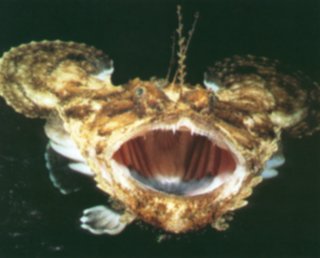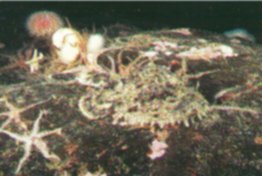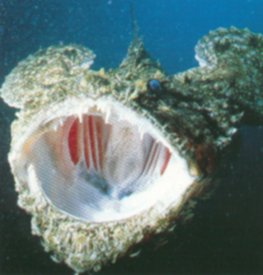
Anglerfish

Order: Lophiiformes Family: Lophiidae Genus & Species: Lophius piscatorius
The anglerfish is a voracious predator which uses a lure on the end of a spine resembling a fishing rod. It attacks any prey which comes within striking distance.
| Habitat Found in the central and north east Atlantic Ocean and the Mediteranean Sea, at depths of up to 450m. The anglerfish spends most of its time lying motionless on the sea bed, often among seaweed, where its skin camouflage is most effective. It often half buries itself in the sand or gravel where it is almost impossible to see. In the spring-summer spawning season, it moves to the shallower waters of the continental shelves where the seas are rich in plant nutrients swept off the land by rivers. The plantlife supports small animals which are eaten by fish and these in turn fall prey to the anglerfish. |
 |
 |
How they hunt The anglerfish is adapted to a sit and wait hunting method. It has a fleshy lure resembling a small worm on the end of a long dorsal fin. It extends and waves this lure to and fro to imitate the movements of a worm. As the prey fish comes close, the anglerfish moves the lure to within striking distance of its mouth. When the prey fish comes close enough, the anglerfish whips away the lure and opens its mouth, sucking in its prey whole and swallowing. Deep sea anglerfish, hunting in pitch black waters, have a luminous lure which they use in the same way. |
| Breeding In spring the anglerfish migrates into deeper water to breed. This helps the young to disperse and to avoid being eaten by their parents. When the female has shed her eggs, the male fertilizes them. The eggs are bound up in ribbons of mucus up to 10m long. When the young fish hatch they rise up near the surface, where they eat plankton. When they are about 7cm long, they begin to take on their adult form and sink to the seabed. |
 |
 |
Behaviour The anglerfish lives a relaxed lifestyle, lying on the seabed, waiting for the next meal to come by. Even if it has to wait a long time, it doesn't matter, because it lies immobile and uses very little energy. Its flattened body has evolved to become greatly reduced to cut its resting energy consumption to a minimum. As its body temperature is the same as that of the water, it doesn't use energy to keep itself warm. The anglerfish occasionally rises to the surface. A specimen was found that had apparantly choked on a seagull. |